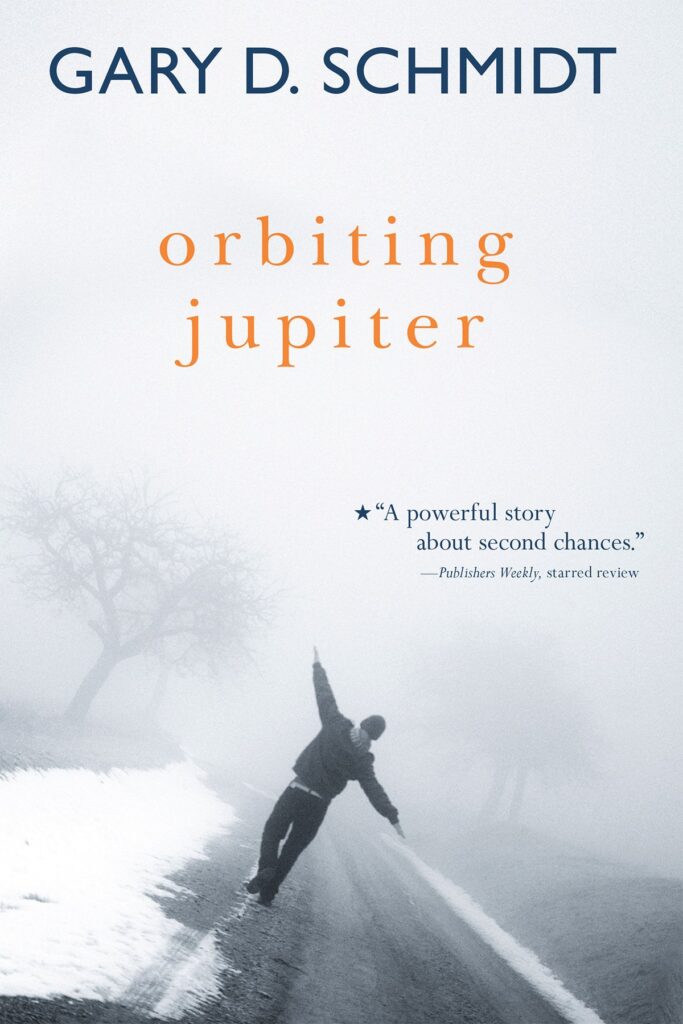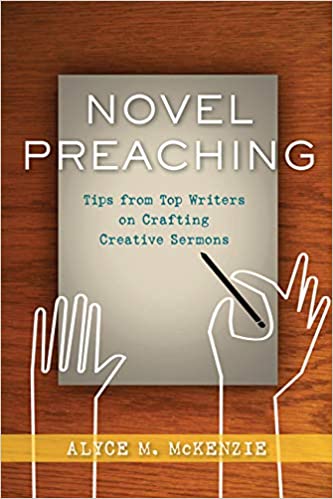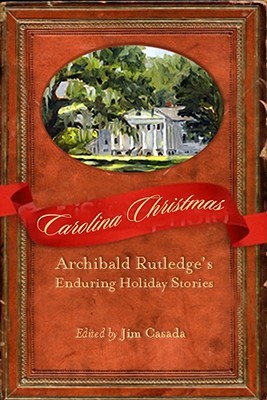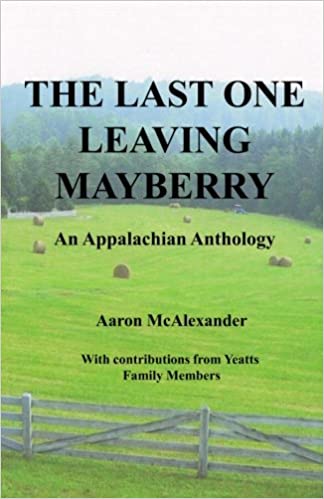Gary D. Schmidt, Orbiting Jupiter
(Boston, Houghton Mifflin Harcourt, 2015), 183 pages.

This young adult novel is about Joseph. A teenage father, he’s sent to a foster family who own a farm in rural Maine.
The family has one other boy, Jack. After getting off to a shaky start, the two become like brothers, watching out for the other. The story centers around what happened to Joseph in his past. When he was 13, he fell in love with Madeline. While Joseph was from a broken family that economically lived on the margin, Madeline’s family was well off. When she became pregnant, they sent her away where she gave birth to a daughter she named “Jupiter.” The planet plays a prominent role in the story as Joseph had pointed it out to Madeline and he often looks for it in the sky. The story’s conclusion occurs around Joseph attempt to find his daughter.
Upon Joseph’s release from Stone Mountain, a juvenile detention center, he find himself with chores to do on a farm. He works beside Jack and makes friends with Dahalia, one of the orneriest cows in the barn. Thereafter, he’s the one who milks her. At school, he struggles with some teachers who think he shouldn’t be in school, but others see promise in him. Joseph is exceptionally strong in math and a prospect for the track team. The story occurs in winter. Schmidt captures the the cold of Maine. When milking, the boys lean in on the cows to capture their warmth.The frozen landscape makes the river dangerous, but also creates an opportunity to ice skate on the family’s pond.
Christmas is especially meaningful for Joseph as he attends church with the family and learns about Joseph, Jesus’ earthly father. He also learns of Mary’s early age. While Schmidt doesn’t mention it, it’s traditionally assumed the Virgin Mary was 14 when she gave birth. This is Madeline’s age when she gives birth to Jupiter. I won’t spoil the ending. However, this book is sad, and I found tears in my eyes. Yet, there’s hope in the child, Jupiter.
Alyce McKenzie, Novel Preaching: Tips from Top Writers on Crafting Creative Sermons
(Louisville, KY: Westminster/John Knox Press, 2010), 180 pages.

As a “working preacher” who has also taught homiletics on a graduate level, I try to read at least one book a year on the craft, along with another book on writing. This year I chose this book, written by a professor of homiletics at Perkins School of Theology, a Methodist seminary in Texas.
Writer’s Conference
This book is divided into three parts. The first two deal with the practice of preaching, where the author attempts to provide the information in a creative manner. In the first part (which is what I thought the book was about from its title), she images being at the Breadloaf Writer’s Conference. Taking her readers along with her, we go from conversation to conversation with fiction authors. As we overhear their discussions, we gain insight into how preachers might us some of the tools of authors to engage his or her congregations in their sermons. We learn about noticing and being aware of what’s important in the text and in our sermons. McKenzie draws from a number of authors including Annie Dillard, Natalie Goldberg, Frederick Buechner, Stephen King, Isabelle Allende, Toni Morris. We gain insight into character, plot, and shape along with picking up ideas of how to journal and to capture such insights into the human condition.
A Cooking Show
The second part of the book involves a cooking show. Here, she draws from well-known (and some not so well known, at least not for me) professors and writers of homiletics. Each one teaches how they approach a sermon, and the reader gets to pick up a recipe card at the end of their presentation. By the time I got to this part of the book, I was a little over with the cuteness of McKenzie’s writings. The writer’s conference wasn’t quite as overblown as this imaginary journey through some kind of convention with all kinds of “chefs,” a few of whom I’ve met, many of whom I’ve read and heard lecture. Those I knew before reading this book include Charles Rice, Fred Craddock, Tom Long, David Buttrick, Richard Eslinger, Henry Mitchell, Paul Scott Wilson, Nora Tubbs Tisdale, Justo Gonzalez, Eugene Lowry and Mike Graves. To her credit, McKenzie draws from across Western Cultures including African American, Korean American, men and women, Protestants and one Catholic example.
Best part of the book–Sermons
I found myself wondering about those not included: Tex Sample (who focuses on the language of the working class), Cornelius Plantinga, Jr (who has written about preaching and literature long before this book’s release), Robert Smith, Jr (an African American who has strong grasp of doctrinal preaching), and Haddon Robinson. The latter really surprised me as his Biblical Preaching may be one of the most popular books on preaching and is the “bible” of expository preaching.
The final section of the book was my favorite. The section consists of a number of creative sermons written by McKenzie. Who’d ever think of angels as UPS workers (after all, angels deliver messages from God which ties into the packages delivered by a UPS driver. I’ll come back to these sermons, I’m sure. McKenzie is able to touch on her audiences fear and concerns and offer a helpful word of reassurance from scripture. I would have preferred to have read more sermons and less of her “tidbits” of information from authors and homiletic professors.
Caroline Christmas: Archibald Rutledge’s Enduring Holiday Stories
edited by Jim Casada (Columbia, SC: University of South Carolina Press, 2010), 225 pages.
Archibald Rutledge was the poet laureate of South Carolina for decades. He was a well-known poet and author writing about nature and hunting during the first half of the 20th Century. Having read several of his works beforehand, I waited till a week before Christmas to read his collection of “Christmas stories.” This book was a gift from my staff in Georgia.
While the book is filled with Rutledge stories, Jim Casada selected the stories included within the collection. Casada also provides insight into when the selection was written, the circumstances around the story, and where it had previously been published. Many of these stories have been published multiple times. First, in magazines (especially Field and Stream, Outlook, and Outdoor Life), and later in collections published by Rutledge.

The book is divided up into six parts. The first section all deals with Christmas stories at Hampton Plantation. Rutledge spent thirty years teaching at Middlebury Academy in Pennsylvania. During these decades, he would always come home for Christmas. In one story, he writes about catching a train during a blizzard up north and arriving on the Atlantic Coast Line early the next morning in the sunny South. His brother meets him at the train station in Charleston and two hours later they’re hunting. Such descriptions brought back memories of me, as a young seminary student, catching a train from Pittsburgh during a snowstorm, heading south to visit my sister the week before Christmas in Florida. When the train arrived in Savannah early in the morning, wearing shorts, I went for a walk along the platform.
A Natural Christmas
The second part of the book, titled “A Natural Christmas,” has selections where Rutledge describes walking in the forest and fields of coastal South Carolina during the Christmas break. Known as a hunter, we are provided a glimpse of Rutledge’s vast knowledge of wildlife, especially birds. While most of these stories are about watching birds, he mentions dove hunting. During such a hunt, in 1896, he shot a bird twice the size of the others. It turned out to be a passenger pigeon. Before Rutledge’s time, these birds flew in vast numbers that would darken the sky. But even by the time Rutledge came along, they were rarely seen. This story was published in 1911. That was just three years before the last of passenger pigeon died in a Cincinnati zoo. I find it interesting the world Rutledge describes had not yet been impacted by chemicals like DDT. Such chemicals have been destructive to birdlife. Reading his prose is to be taken back to a more primeval world.
Deer Hunting
Deer hunting is the focus of the third part of the book. Such hunting on the coastal plain is done with shotguns. In telling the dangers of using rifles in such flat terrain, he draws on a familiar form of transportation of his day. “Express bulletins don’t make no local stops,” he humorously notes. Around Hamilton, deer hunting was also done with dogs who would chase the deer out of the bays and swamps. While I never hunted with dogs, I did go a few times with my father. I was not yet old enough to carry a gun. We were stationed along a remote road. We froze while waiting and listening for the dogs to drive the deer out way. While my dad did shoot several deer, he never did when he had my brother and me in tow. Again, these stories are filled with wisdom and insight into hunting. My favorite of his deer hunting stories was the last. In this story, he prepared to take his son hunting when he returned from Europe after World War Two.
Other Game
There is a small section of stories about hunting other wild game, especially turkey and quail. He mentions squirrel, rabbit, duck, and ‘coon hunting, but his stories are mainly limited to deer, quail and turkey. There is also a very short selection of seasonal poems. Casada feels his poetry hasn’t “aged” as well as his prose. One of the three poems, “Christmas Eve on the Rapidan (1863)” was set om the Civil War. Rutledge’s father was one of the youngest colonel’s in the Confederate army. The last section of the book has a number of recipes.
Rutledge is a master at describing the land in which he’s hunting and the “chase” of the deer. His stories often contain humor, and the hunter doesn’t always come away with dinner. On one occasion he notes that after a week, they were still eating pork. In another story, he writes about a turkey hunter who followed a bird into a tree. Moving closer on Christmas Eve, as the light drained from the sky, he saw two dark figures in a tree. Not able to determine which was the bird and which was a clump of mistletoe, he fired and guessed wrong. The bird flew as a chunk of mistletoe fell to the ground. He picked it up to carry home for decoration. I also remember shooting mistletoe from a tree. It was an easy way to harvest the seasonal green, however the white berries often don’t survive the fall.
Rutledge and African Americans
These stories are dated by Rutledge use of the term Negro for African Americans. While they were no longer slaves, they were still bound to the land and held a subservient role. During deer hunts, white hunters were stationed around a swamp or bay, while African American men led the chase. Using dogs, they’d go into the swamps to flush out the deer. One has to remember that Rutledge is writing from another age. While he often speaks highly of African Americans as a race, especially his childhood friend Prince, there is a separation. He lived in the big house and they lived in the shacks around the plantation. These stories were all written in the first half of the last century. At the time, long before the Civil Rights Movement, Rutledge saw no problems with such relationship. Anyone reading this book today needs to understand time has changed and realize Rutledge was blind to such injustices.
Aaron McAlexander, The Last One to Leave Mayberry
(Stonebridge Press, 2011), 219 pages, a few b&w photos.

McAlexander’s family is from Mayberry even though he grew up in Meadows of Dan, which is located three miles north of Mayberry. In this book, he along with others from his family tell of their ancestor’s moving to this hardscrabble mountain terrain.
Today, there’s not much in Mayberry. There’s the church and there’s the store. Even in the good old days, there wasn’t much to Mayberry. The store also had a Post Office, but that closed in the 30s. There was a tannery and a number of diaries along with a school. Although the community is sparse, it created many good memories that McAlexander mines to create this collection of short stories.
If you read this book, you’ll learn about trout fishing, the first telephone in the community, and the depression (that Mayberry seemed to experience long before the rest of the country). There are stories about men going off to World War 2 and a training flight over the mountains that crashed in the dark hours of morning in 1945. You’ll learn about a “suck-egg dog” (beside being a nasty term for one’s enemies). You’ll learn of the influence of the Blue Ridge Parkway, which divided farms, and about a blacksmith who became a Presbyterian preacher, who occupied the pulpit I currently attempt to fill. You’ll learn of mysteries that still remain mysterious. You’ll read about people who make a break for the West, only to come back home. McAlexander himself headed off as a physics professor, but upon retirement maintains a cottage in the community in which so many of his relatives reside (many of whom are below ground). This is a delightful book with good stories.

What a worthy collection, Jeff. Character-driven with a lot to teach us I suspect–not surprisingly!
Thanks! While there are a lot of good character sketches in the Mayberry and Carolina Christmas books, as well as the Orbiting Jupiter YA novel, all three also have a strong sense of place (Blue Ridge Mountains, Eastern Carolina pine country, and rural Maine).
I would love to read “Aaron McAlexander, The Last One to Leave Mayberry”…..
I think this is typical Americans, they are moving due to many reasons, including find new opportunity in new areas (states).
Thank you for sharing other reviews. All interesting
While my enjoyment of the “Mayberry” book was heightened by living here (and knowing some of these places), I think you’d get into his stories. Send me an email if you can’t find a copy and I’ll see if I can help you out.
Happy New Year, Jeff! I always enjoy hearing about the books you read. “Homiletics” is a new word for me, and I guess I shouldn’t be surprised that there is such a genre. I hope you fill the new year with lots of inspiring and fun reading!
Homiletics is a ‘trade term” and isn’t really used in the vernacular. There, people just say “preaching”
Seems like you love reading and have read some interesting books! Lovely Post! Happy New Year 2021 <3
Allurerage
Thetrendybride
Thanks for stopping by, Jiya
Looks like you’ve read some good books. I hope you find more books you like in the coming year. Happy New Year.
I will always find books to read. You should see my TBR pile… probably is, every book I pull off, I put two on!
My favorite would have to be Orbiting Jupiter. From your review it definitely feels like a book I could connect with.
I think you might like many of his books. “Lizzy Bright and the Buckminister Boy” is a YA historical fiction with a powerful message (of a racial purity campaign in Maine). I will always like his book, “Wednesday’s Wars,” partially because it is a coming of age story from my own time.
Carolina Christmas is definitely on the TBR. I’m a part-time vegetarian but it’s only because of preference, and certainly not associated with PETA. Good reviews, all.
His stories do take us back to an earlier era!
Carolina Christmas does take one back to the “old South.” It would not be a book I’d recommend to my favorite vegetarian or PETA activist!
Well, you have to remember that despite being a vegan (for almost six years now!), I still fish, have done my share of hunting, and have beef cattle in the pasture. 😉
You’ve read a nice variety. I’m especially drawn to Carolina Christmas.
Mary was 14… that puts a lot of things in perspective!
Strong sense of setting in a lot of the books you’re reading.
We don’t know for sure, but apocryphal sources suggest she was around 14. However, Scripture does not confirm such an age. Supposedly, she could have been “betrothed” at age 12 according Jewish customs of the time.
I always like writing that has a strong since of place that grounds the work.
Mary was a teenager. Of course – not uncommon for most of human history. It’s interesting how our modern sensibilities alter our perceptions of such stories.